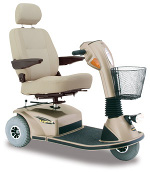The Wheelchair Guide
Your Wheelchair and Mobility Scooter Resource
Mobility Scooters: The Accessibility Accelerator
Monday, September 7th, 2009
 One of the most common types of mobility vehicles used by seniors to improve accessibility and make it easier to get around is the electric scooter. These devices have been around for over fifty years, but they did not become popular until the 1980′s, when the price of electric scooters was decreased.
One of the most common types of mobility vehicles used by seniors to improve accessibility and make it easier to get around is the electric scooter. These devices have been around for over fifty years, but they did not become popular until the 1980′s, when the price of electric scooters was decreased.
Basic Mobility Scooter Design
Electric scooters, which are most often referred to as mobility scooters or adult scooters, are intended to be used by those who have difficulty walking for extended distances. The user sits in a chair that is mounted to the base of the mobility scooter, controlling it by a set of handlebars, called the tiller, that extend from the front of the device.
Using the tiller, which can be adjusted to accommodate people with different arm spans and of differing size, the senior can control the direction of the mobility scooter, its speed, and any other components the scooter may have, such as its headlights.
The tiller extends from the front of the mobility scooter, while the chair is positioned more towards the rear. As a result of this design, it is not possible to drive a mobility scooter directly up to a table in the same way you could a wheelchair. Instead, it is necessary either transfer to an actual chair or parallel park the mobility scooter next to the table.
This is the major difference between mobility scooters and electric wheelchairs, making mobility scooters more practical for those who are able to walk on their own. However, there are some wheelchair users who like to use mobility scooters for outdoor use, but do not rely on them for their daily activities. Among wheelchair users, the heavy duty mobility scooter is most popular, as it is designed to be driven over almost any type of ground, has a much larger per-charge traveling distance and top speed than most wheelchairs.
Rechargeable Batteries and Range
Like electric wheelchairs, mobility scooters use a rechargeable battery system for power. Depending on the model and type of mobility scooter, the range of these devices can greatly vary. Typically lower end mobility scooters have a range of less than 5 miles per charge. Higher end scooters have a much larger range, usually between 10 and 20 miles per charge, with some heavy duty scooters exceeding 40 miles in a single charge.
Usually the price difference between a low end model and one that has a better per charge range is not very large, especially when you consider the difference in quality.
Advantages of Battery Packs
Some mobility scooters use a battery pack system, which allows the battery to be removed easily by simply pushing a release button. Others use a battery system more similar to an automobile, which has wires that must be removed in order to replace the battery.
One of the main advantages of a mobility scooter with a battery pack is that users can purchase an extra battery pack for the scooter. When one battery pack runs down, they can then quickly switch it out and be ready to go again, leaving the other battery pack to charge. This is popular amongst those who do a great deal of traveling with their scooter or consistently drive further than its single battery range.